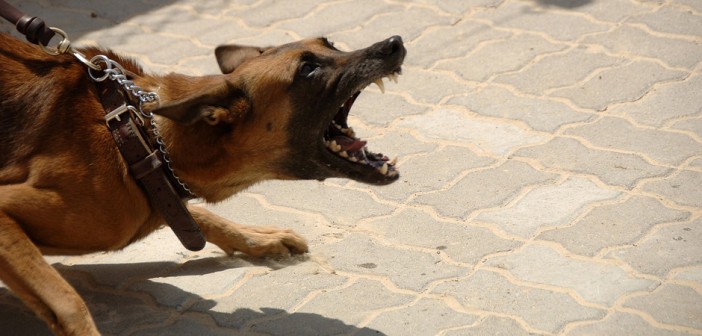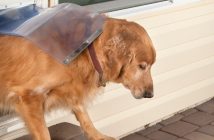Leash aggression is one of the most common behaviors that pet owners like you will have an encounter with. How exactly are you supposed to solve it? This guide helps you address that question by giving you seven tips that you can implement with your pet.
Leash aggression can be defined as a specific type of behavior wherein your pet dog acts aggressive towards you, towards other people or towards other animal when he is on the leash. Pet owners like you often panic when encountering this behavior for the first time – I mean, if your dog is normally sweet and friendly, then how do you explain the fact that he turns into a snarling and growling canine terror when he meets someone else while he is on the leash?
Luckily, though, the cause of leash aggression is easily defined. Therefore, you can actually handle leash aggression quite well as long as you know what factor is causing it. Are you ready for the answer?
Frustration and pent-up anxiety can cause your dog to act aggressively when he encounters a stranger while he’s on the leash:
- You see, your dog loves investigating strangers when he meets them for the first time so that he can determine if the stranger is dangerous or not.
- When he’s on the leash, he can’t freely investigate the stranger so he doesn’t have any information on him.
- He’s terribly frustrated because the leash is trapping him so he attacks you, the one holding the leash, to express his frustration.
- And at the same time, he’s very scared of the stranger because he doesn’t know anything about him so he acts aggressively towards the stranger in hopes of scaring him away.
Now that you know the cause of your dog’s leash aggression, let’s go to the seven tips that can help you solve this kind of behavior.
- Become alert to the earliest signs of leash aggression.
You can only be able to handle the leash aggression properly when you’re aware of the changes that occur when he turns into an aggressive spitfire. We should be aware first before taking any action, right? Check the following for leash aggression signs:- Ears, head and neck body language
- Eye shape and expression
- Tail movement
- Overall body posture
It’s better for you to start intervening at the first sign of the problem so that you can prevent it from being a habit later on.
- Adapt a joyful, cheerful and upbeat tone whenever walking your dog.
Giving off a cheerful and relaxed vibe to your dog whenever you feel that he sees an unfamiliar dog or stranger makes him feel more at ease with the situation.
Think of this suggestion while keeping your dog’s mindset into consideration: when he sees you tense and become nervous, he becomes overprotective and thus, he starts exhibiting aggressive behavior.In the same train of thought, if he sees you give him a command in an upbeat and fun behavior, he would assume that nothing is wrong so he’s less likely to act aggressively. Also, it would be better for you to give him a cheerful command and walk him away from the situation so that he wouldn’t feel threatened.
- Change your dog’s emotional state by modifying his physical posture.
It would be very difficult for your dog to remain aggressive when he is comfortable and relaxed so you can actually solve his aggressive behavior by asking him to sit. Sitting is a neutral position that does not encourage aggression so it’s one of the best positions for your dog to adapt.Once he’s properly seated, use your hands to stroke his ears, mouth and head to lead him to a relaxed position – keep in mind that you’re essentially subtly commanding him to relax, not petting him, so use firm strokes instead of gentle ones.
- Never use physical, verbal or any other form of punishment.
How would you like it if your parents punished you for being afraid of someone? This is basically what it would feel like for your dog if ever you punish him while he’s displaying on-leash aggression.Punishing your dog can cause him to feel that he has the right to be scared or that he should hide his fear from you – both of these feelings can cause him to act even more aggressively towards you, even if he doesn’t intend to.
- Loose some of the tension on the leash – but still keep him controlled.
For your pet dog to minimize his aggression, command him to sit using an upbeat tone and when he is already in his sitting position, release some of the tension on the leash immediately. Knowing that he has some freedom will cause your dog to be more comfortable with his surroundings.However, keep in mind that you still need to keep your hand on the leash so that you can control him, if needed. If he changes his position, repeat the command and re-position him.
- When walking him, give him treats when other dogs approach you.
Have some of his favorite treats with you while you’re walking him so that when you encounter unfamiliar dogs, you can consistently reward him with treats, food, toys and verbal praise. What you’re supposed to do to distract him is to throw a treat on the ground and say “find it!”.
Redirect his anxiety and convert it into comfort by practicing this helpful tip for at least two weeks. - Visit your dog’s veterinarian.
Sometimes, even though you have successfully implemented these tips, your dog may still continue to exhibit on-leash aggression. For you to rule out the possibility of a medical problem, the best way is to consult expert advice from an official veterinarian. Don’t just rule this out yourself unless you’re really an official vet.




